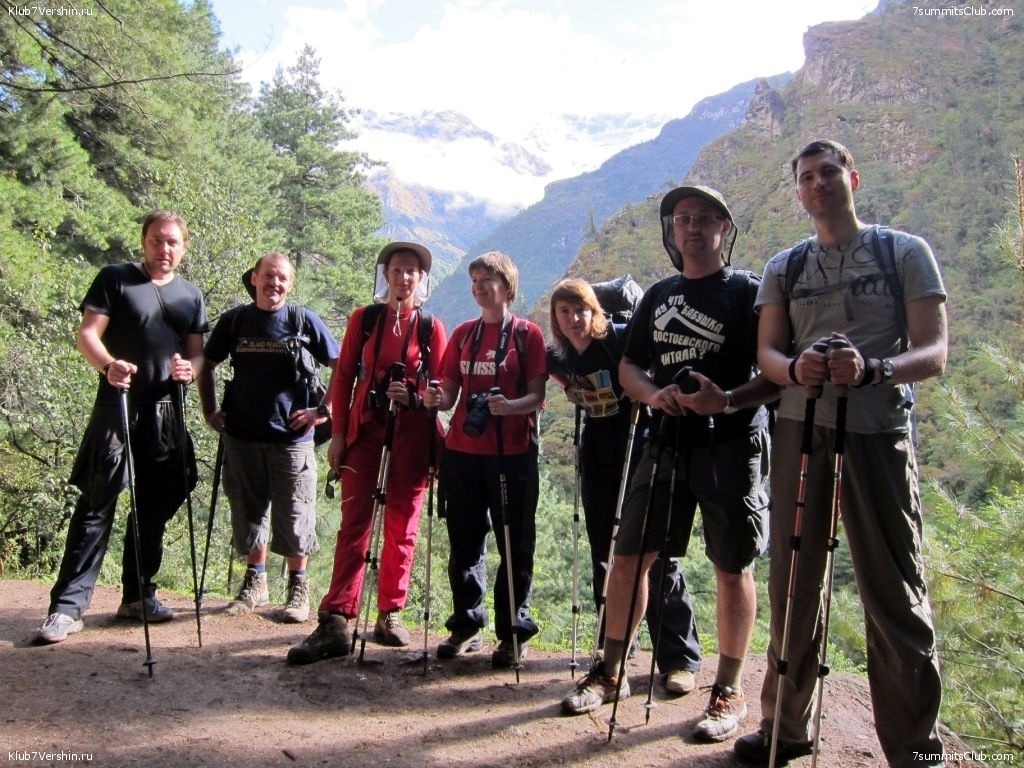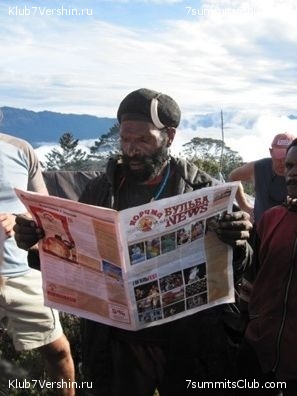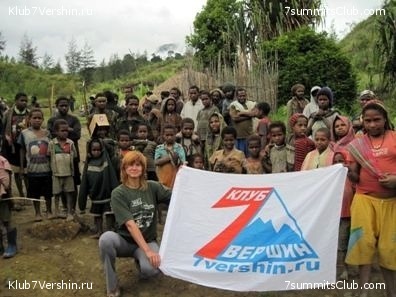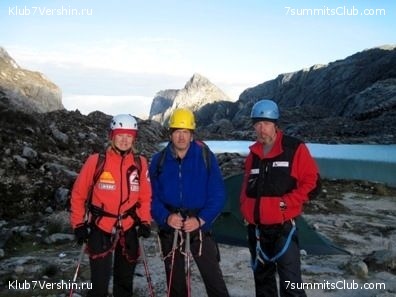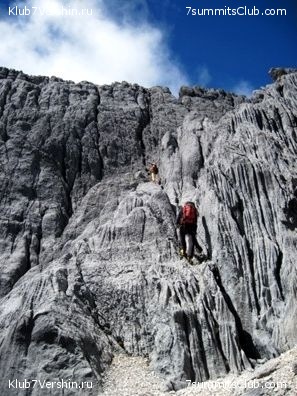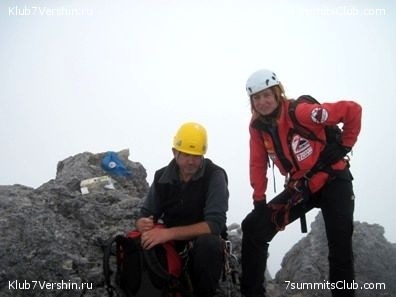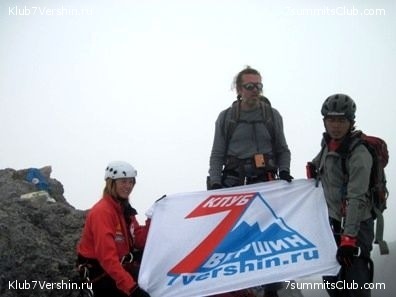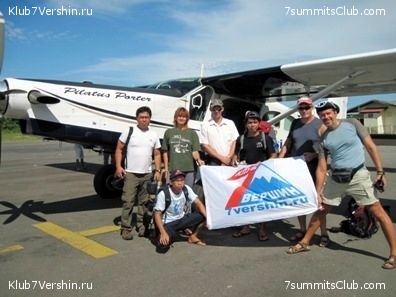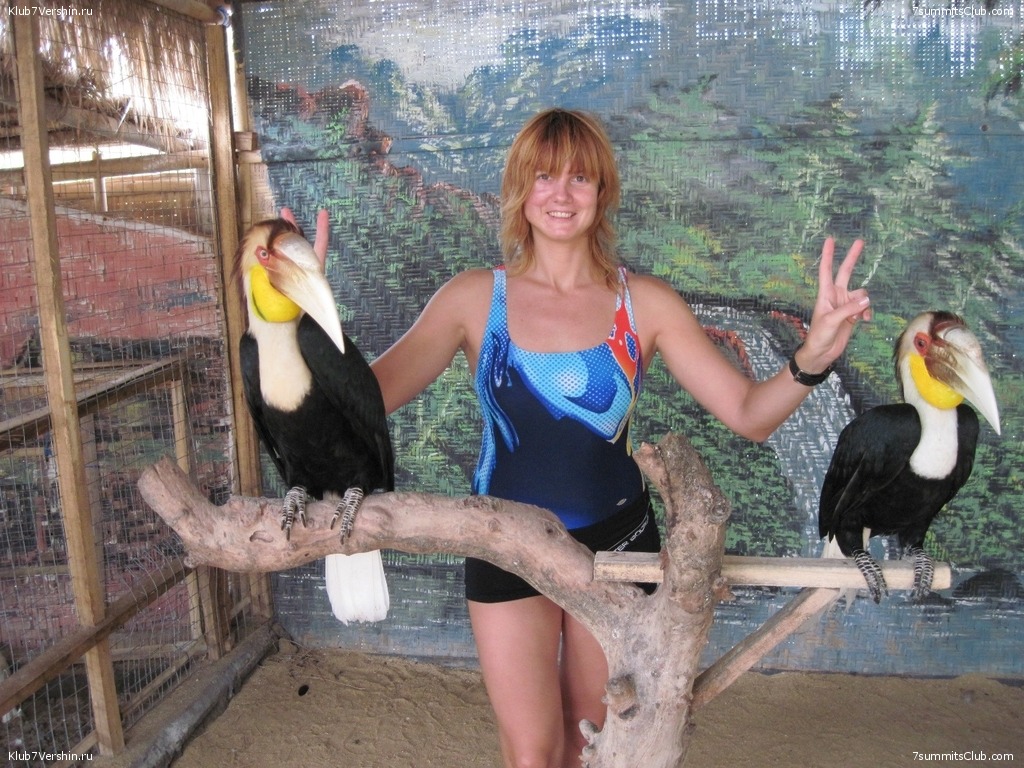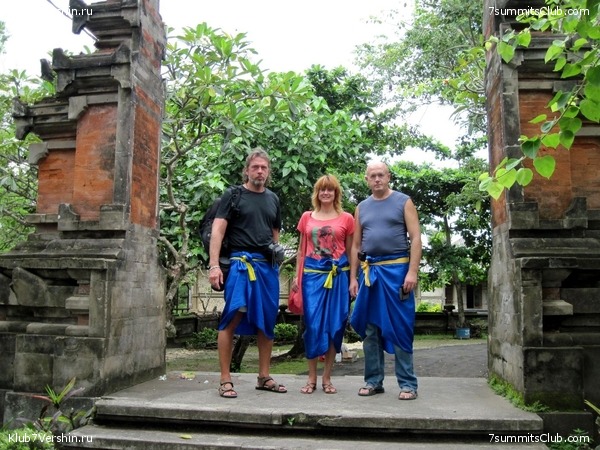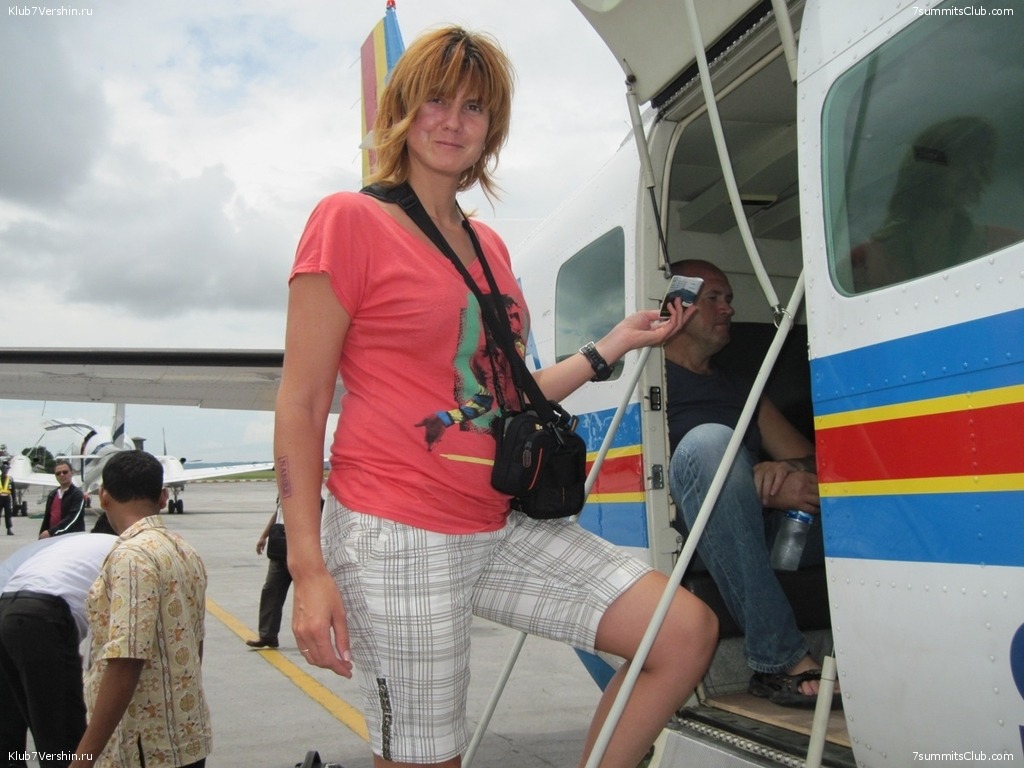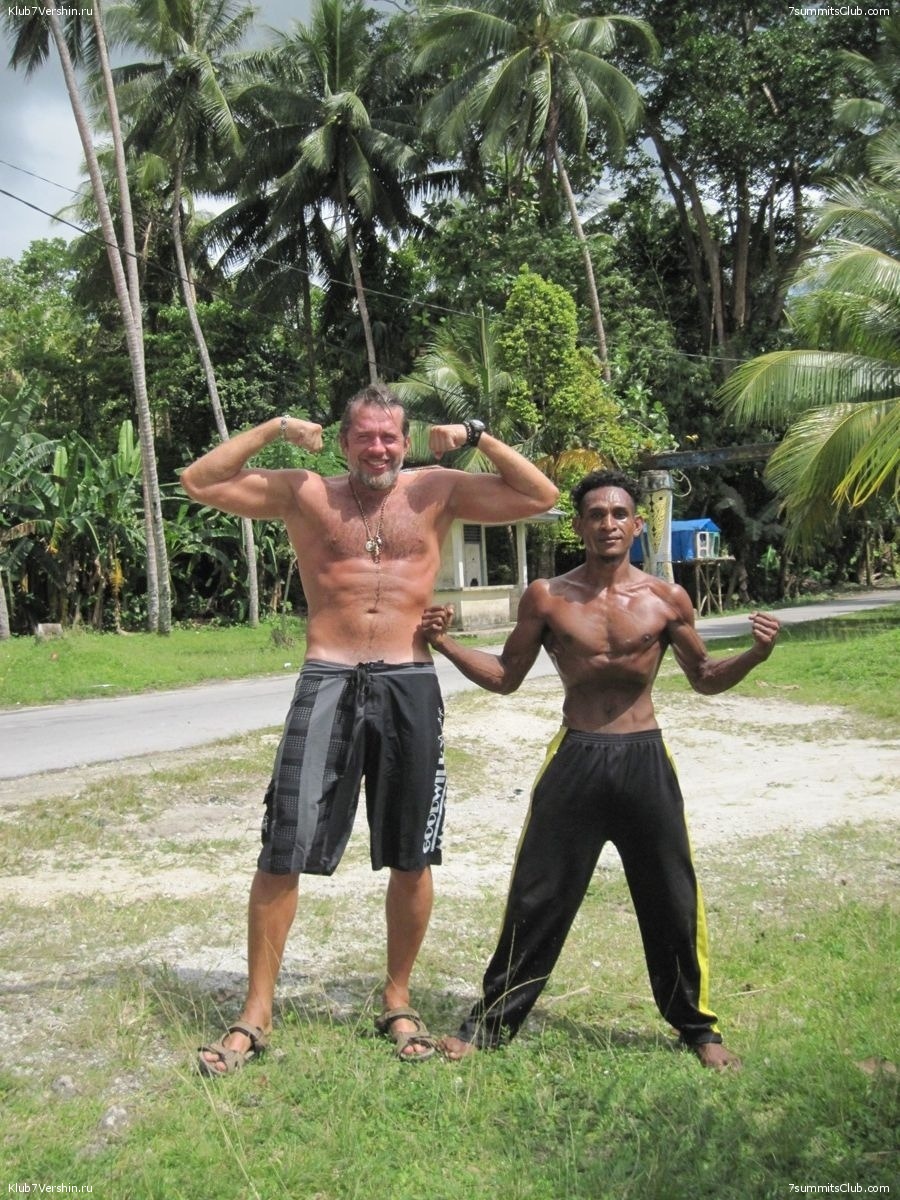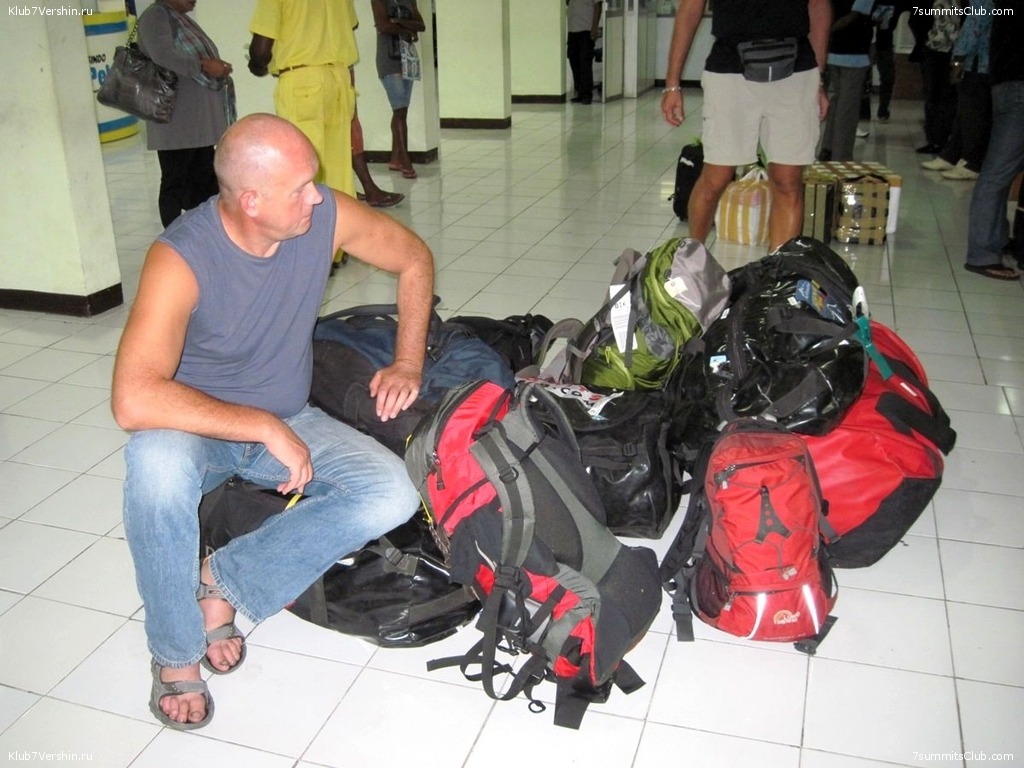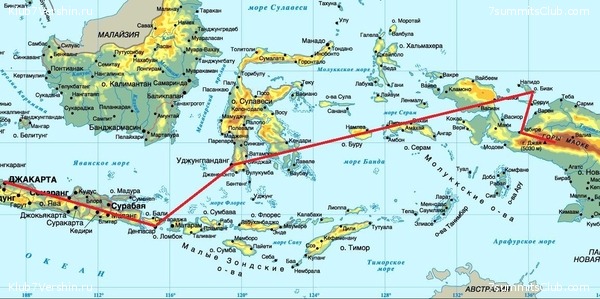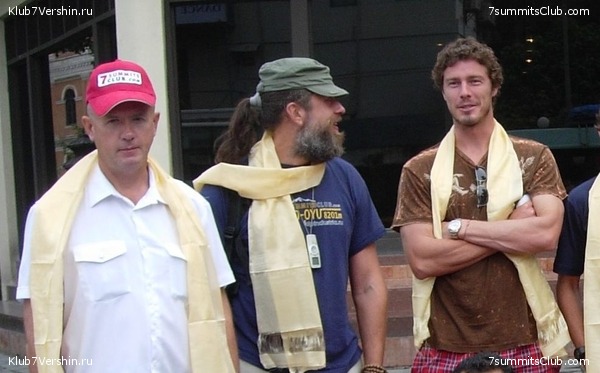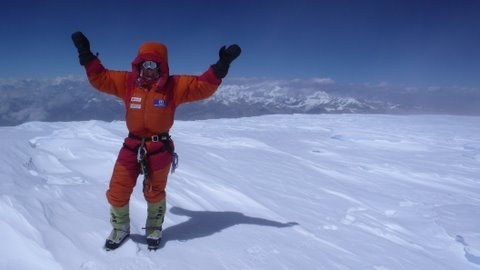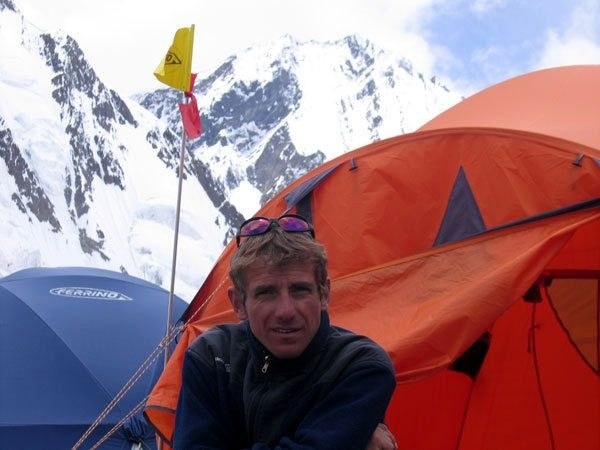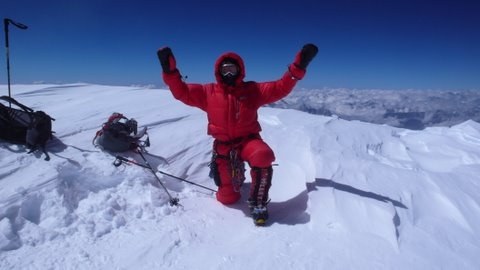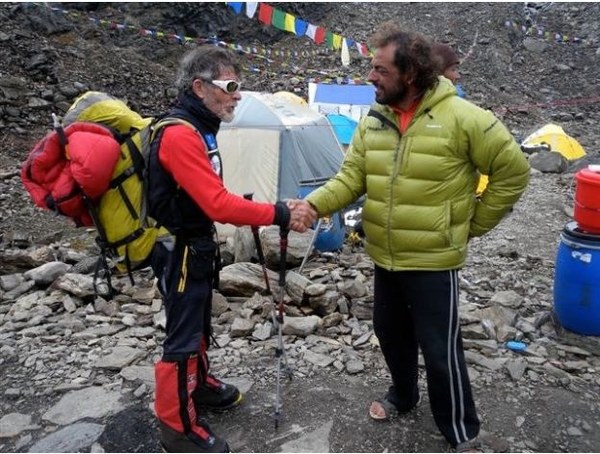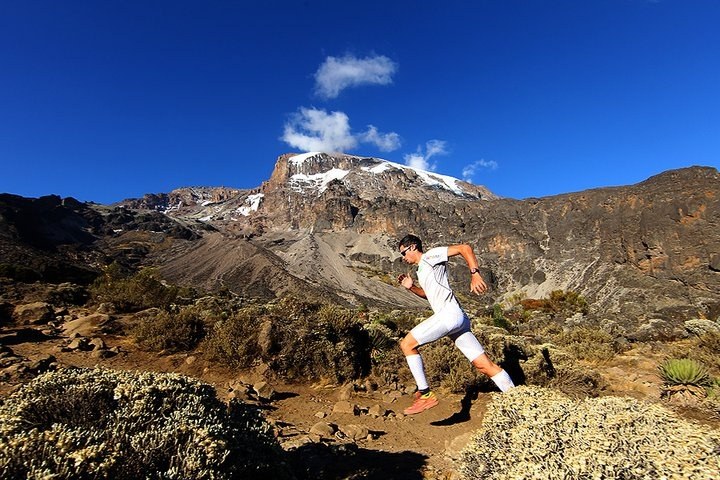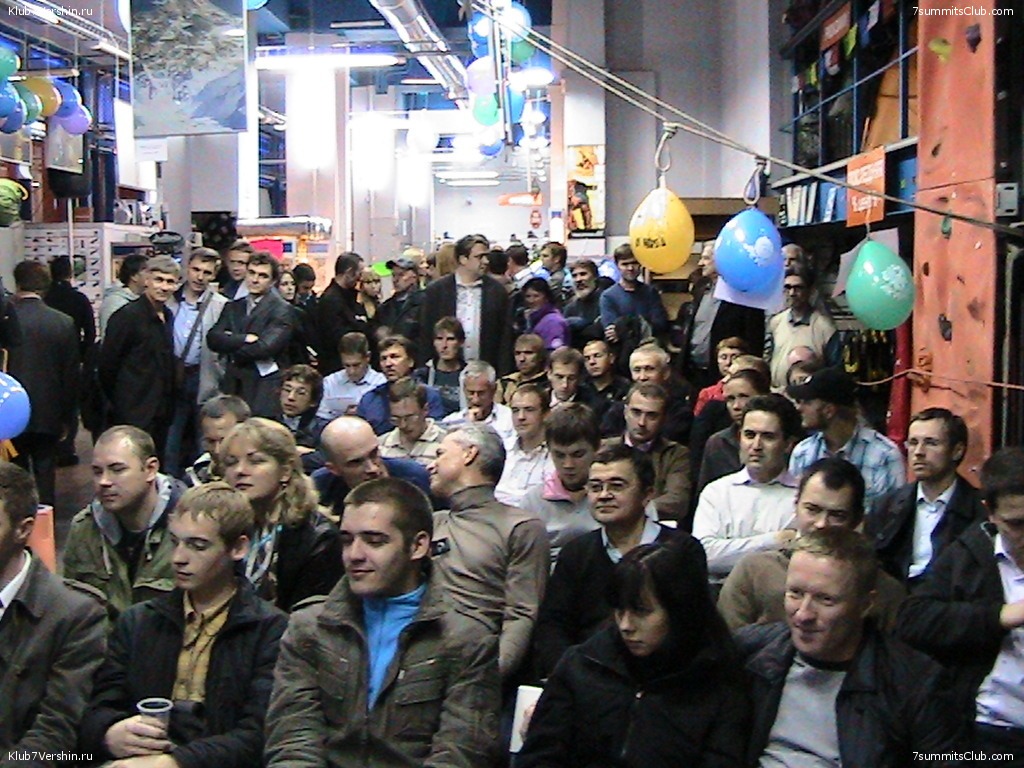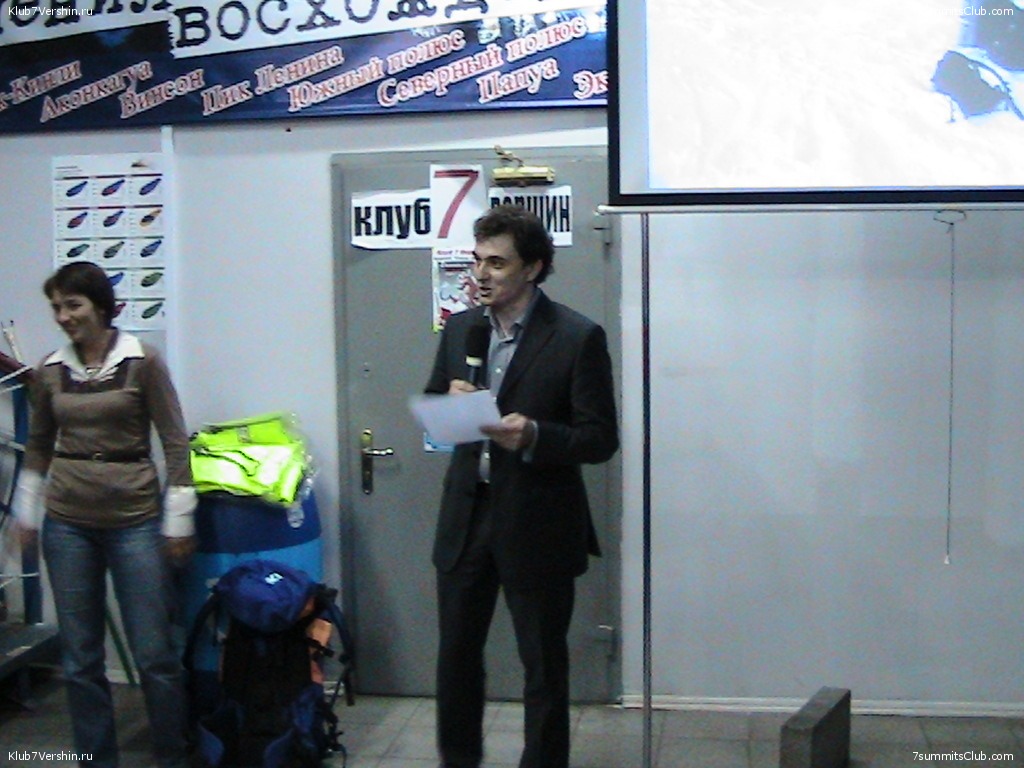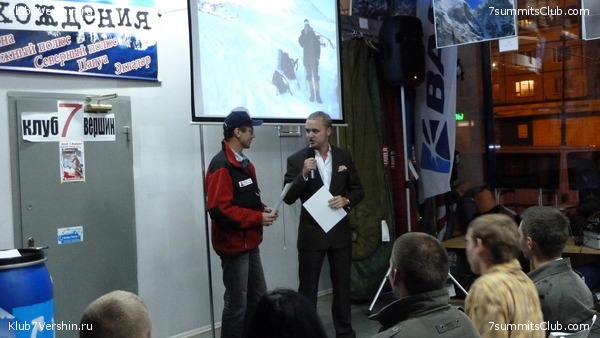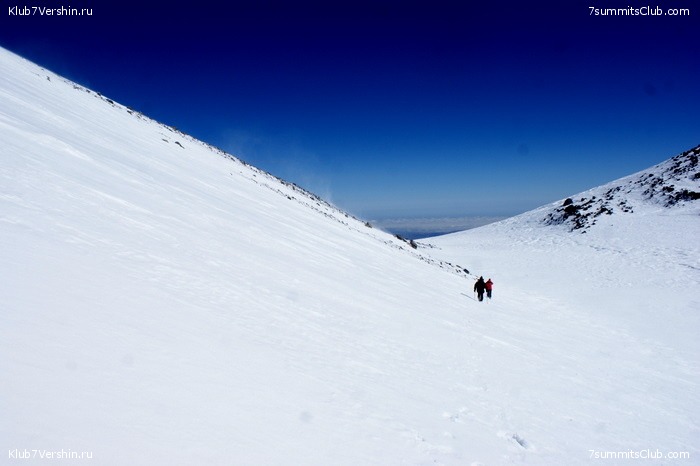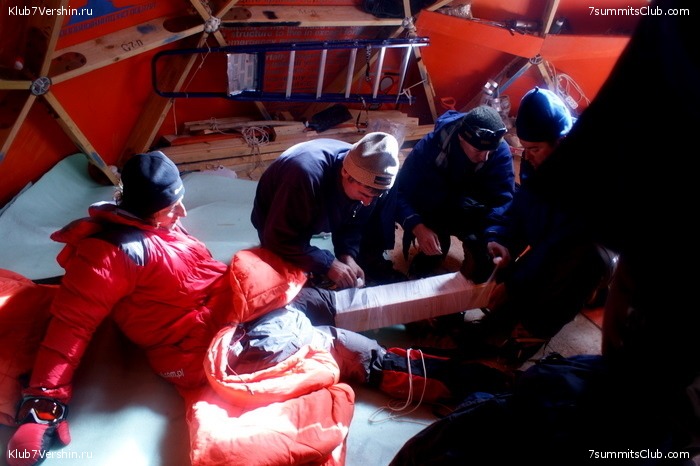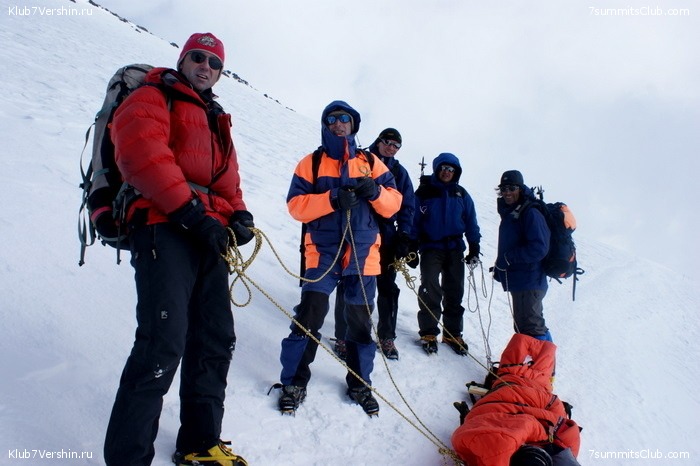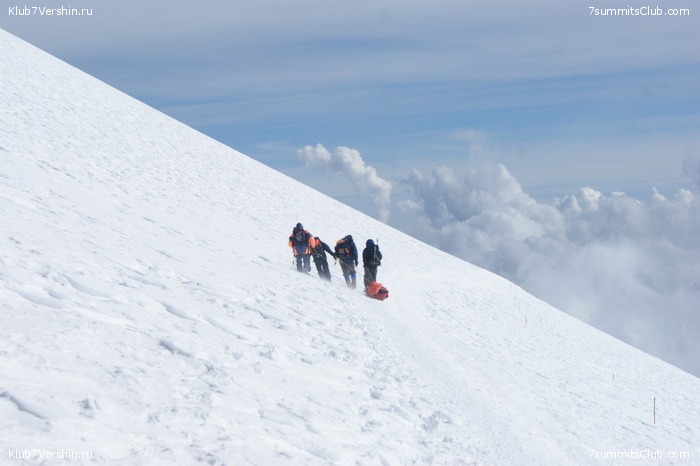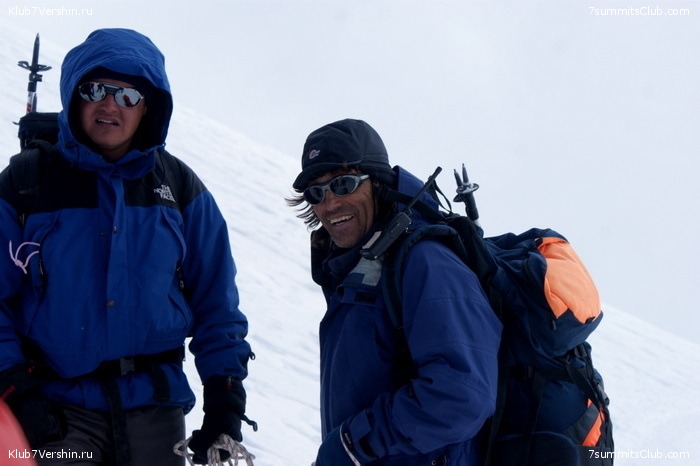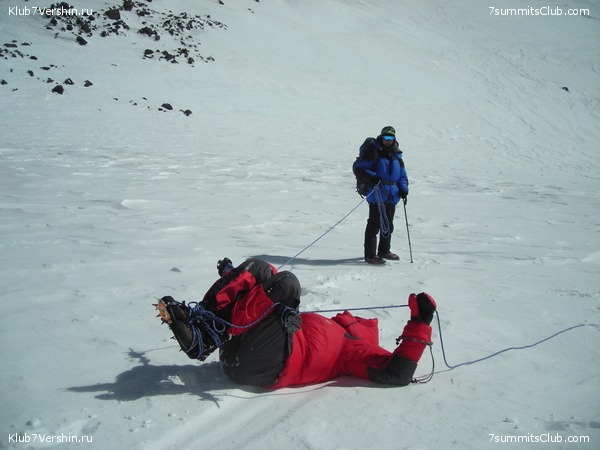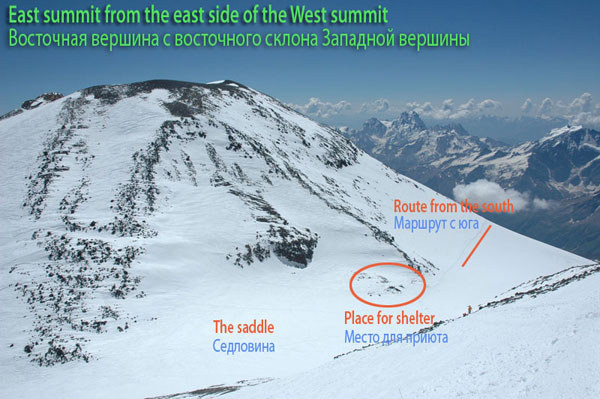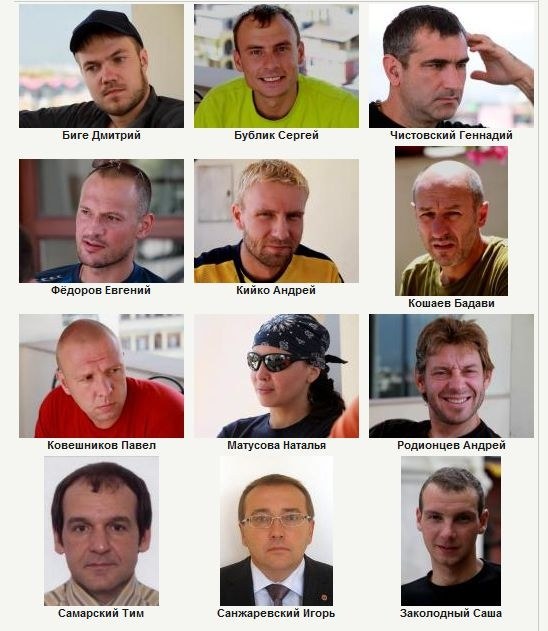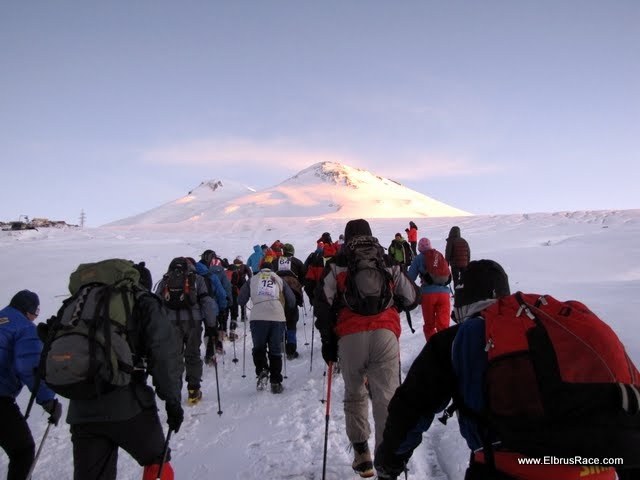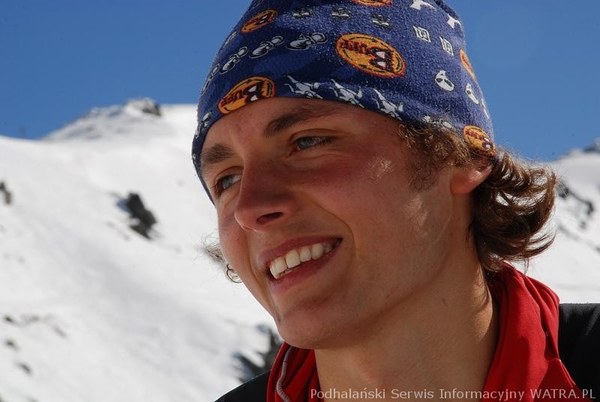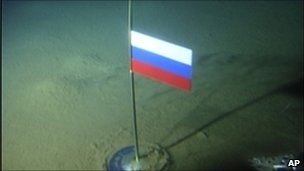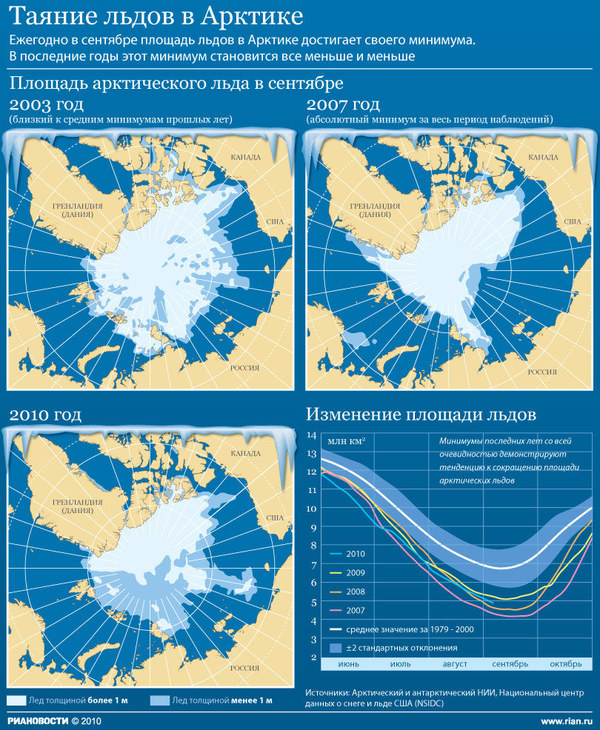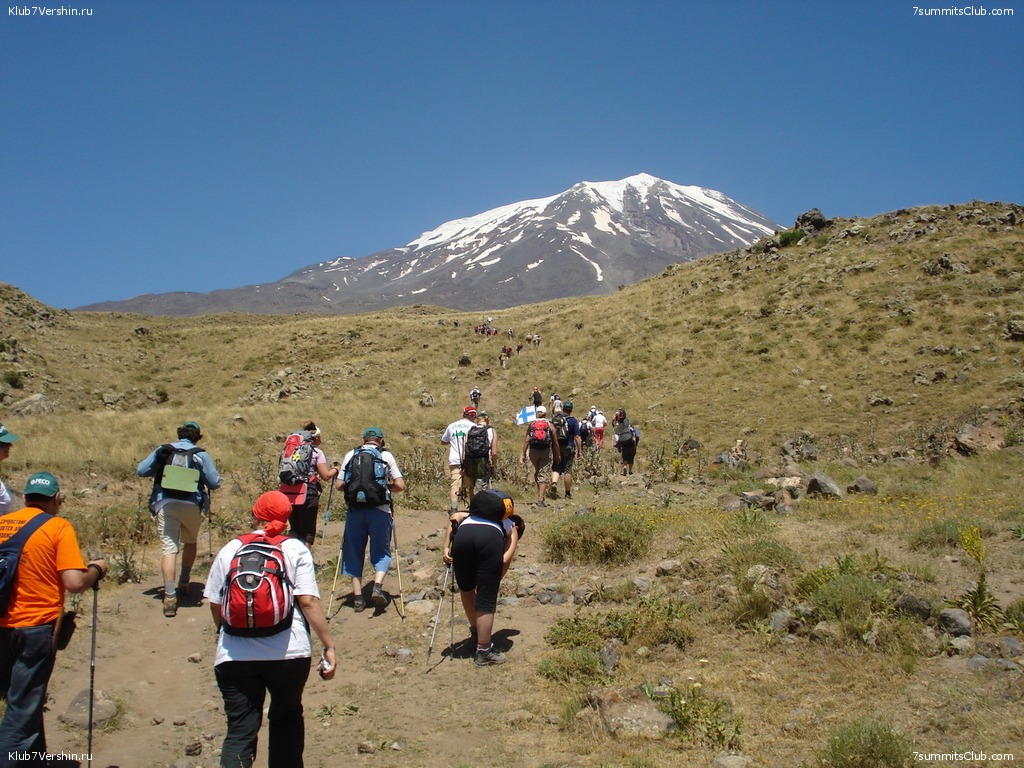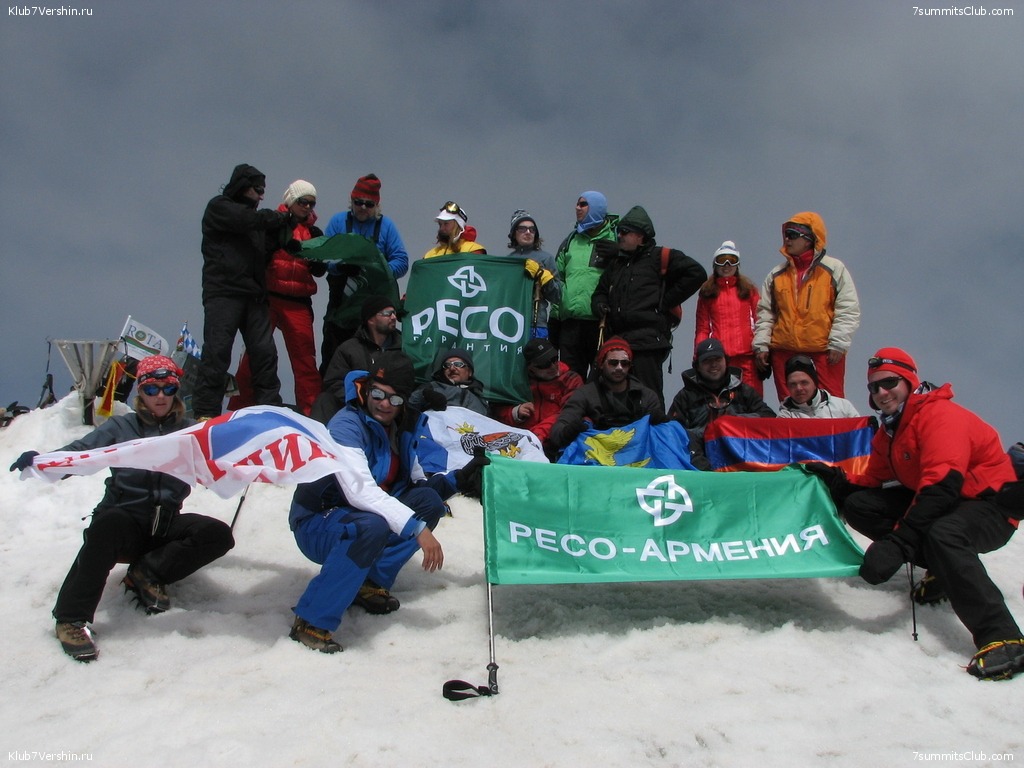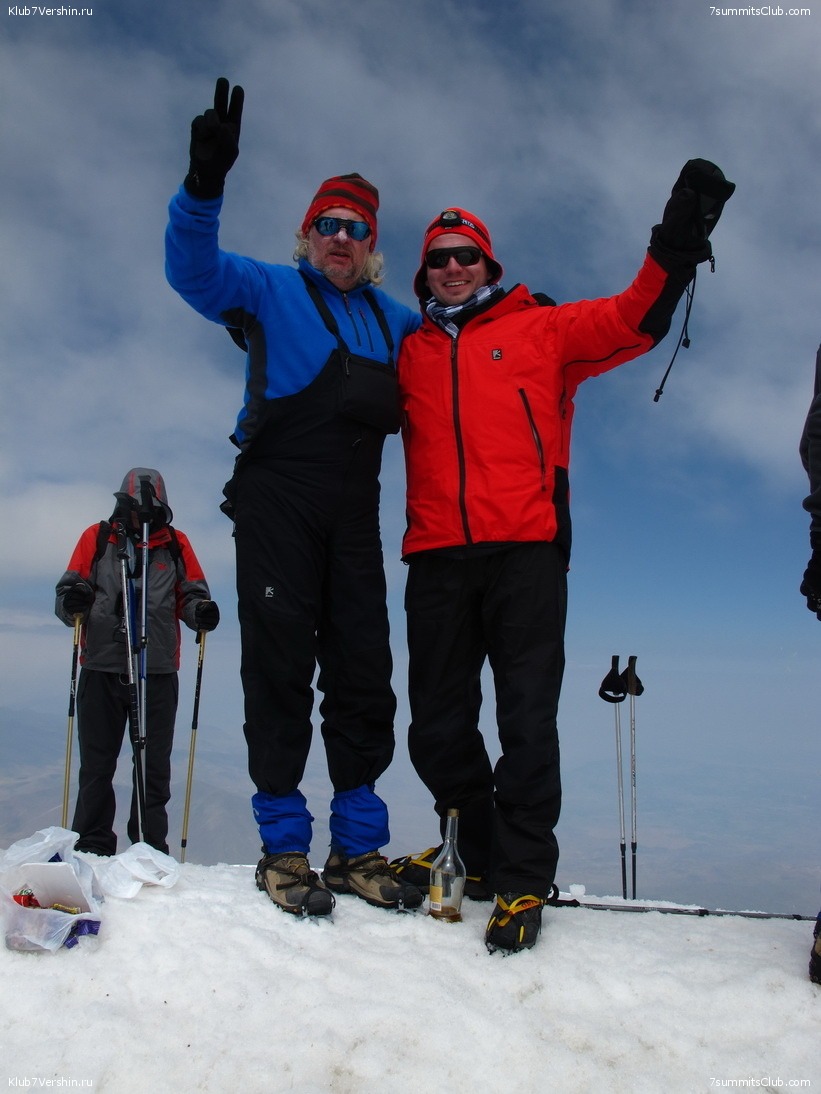All news: 2010
Group Victor Bobok is in Lobuche. Tomorrow go to the base camp of Mount Everest
Today, a group of 7 Summits Club under the leadership of Victor Bobok successfully overcame the Cho La Pass, leading from the valley Gokio in the Khumbu valley itself. For overnight they stopped at a lodge in the village of Lobuche. For ...
Today, a group of 7 Summits Club under the leadership of Victor Bobok successfully overcame the Cho La Pass, leading from the valley Gokio in the Khumbu valley itself. For overnight they stopped at a lodge in the village of Lobuche. For tomorrow is scheduled early exit, to climb Kala Patar, then to reach a place of base camp of Mount Everest and still have time to get down lower than Lobuche. All members of trip feel very good. And in the morning, and in the afternoon and in the evening. Especially at evening party. The fact is that six of seven members of the expedition play guitar quite well.
Group of Ludmila Korobeshko emerged from the jungle ....
Carstensz Pyramid.
Hi ! Finally we got out of the jungle ! Hooray ! It was not easy. Thus, 16 October, we ran into (less than 5 hours) to the top of Carstensz Pyramid (4884m) from the base camp. The weather favored us up to the summit. At 11 a.m. local time, ...
Hi ! Finally we got out of the jungle ! Hooray ! It was not easy. Thus, 16 October, we ran into (less than 5 hours) to the top of Carstensz Pyramid (4884m) from the base camp. The weather favored us up to the summit. At 11 a.m. local time, we stood at the top, the members of the 7 Summits Club - Igor Kosarev, Yuri Beloyvan, Ludmila Korobeshko.
During descent the weather turned bad and we went down along wet ropes.
The next day, porters did not come. We are agitated. The day was lost. A day later they came and we all ran together down in the snow (first) and rain. Until Pinapa (a village near Ilaga), we went for 4 days. On the last day we made almost 2,5 day distance, and last 4 hours went in complete darkness in the jungle and swamps. At 10 p.m., our team came to the village. Local residents greeted us with shouts and laughter. They carried us in the guest house to Mr. Luther and his wife, Nani.
We are planning to fly to Vamena, on a visit to this ritualistic cannibals.
Success on Carstensz Pyramid: our congratulations !
Carstensz Pyramid.
Today, 16 October, the team of " Seven Summits Club ", Ludmila Korobeshko, Yuri Beloyvan and Igor Kosarev climbed the summit of Carstensz Pyramid, considered the highest in the Australian continent. Details are not known to us yet. The ...
Today, 16 October, the team of " Seven Summits Club ", Ludmila Korobeshko, Yuri Beloyvan and Igor Kosarev climbed the summit of Carstensz Pyramid, considered the highest in the Australian continent. Details are not known to us yet. The group descended to the base camp and getting ready to go back through jungles to Ilaga Village and then by planes home. Ludmila Korobeshko became the first Russian woman completed the "Seven Summits" according to 7 + 1 version.
Alan Arnette: Himalayan Successes of Different Types
Everest.
Climbing Himalayan mountains in the Fall can be risky at best. Each day is shorter, it is progressively colder and winter looms. So every summit, especially Everest, is highly valued by the climbers. This year, Fall 2010, we saw two summit ...
Climbing Himalayan mountains in the Fall can be risky at best. Each day is shorter, it is progressively colder and winter looms. So every summit, especially Everest, is highly valued by the climbers. This year, Fall 2010, we saw two summit successes of very different types.
First up is the only Fall Everest summit since the Fall of 2008. Eric Larsen and his small Sherpa team summited Everest at around 6:35 AM local time on October 15th. They broke trail and fixed their own ropes on the way to the top. Eric reported in an emotional audio post from the summit that they summited . He later reported they threaded the needle of a tiny weather window descending in white-out conditions to the South Col. He promised more details upon return to Base Camp.
His outfitter, Himalayan Trailbalzer listed the Sherpa team as: Mr. Tshering Sherpa, Pasang Temba Sherpa, Mr. Nima Dorje Tamang, Nima Dorje Tamang, Dawa Gelzen Sherpa, Pasang Dawa Sherpa and Da Tenji Sherpa.
There had been other teams on both the north and south but all abandoned plans throughout the season. Dangerous snow conditions were the culprit on the north side and running out of time was cited on the south. But Eric, wanting to complete a year long goal to ski to both poles and summit Everest on behalf of his "Save the Poles" mission persevered. Eric's stated goal:
"This expedition will tell the story of these remote places so we can better understand how our actions affect the poles and ultimately the planet," Larsen says. "We all need to be reminded that we must act now to stop global warming."
Please visit his website for more details. Congratulations Eric!
Another impressive summit was the Soldiers to the Summit team lead by Everest summiter and blind climber Eric Weihenmayer. They put 8 soldiers on the summit of Lobuche, 20,075′, which is often used for acclimatization for Everest climbs. From their site, Soldiers to the Summit: The goal of the Expedition and World TEAM Sports is to demonstrate to everyone that great things can be achieved no matter how high the obstacles.
From the team website:
We did it! On October 13th, eight of our injured soldiers reached the 20,075-foot summit of Lobuche. These men and women overcame their injuries, gave it their all, and achieved a great victory—not only for themselves but for other veterans, disabled people, and all of our sponsors.
We set out from high camp at 17,000 feet in two teams. The first team—consisting of Brad Bull, Steve Baskis, Sherman Bull, myself, Jeff Evans, Kami Tenzing, Ashley Crandall, Michael Brown, Rex Pemberton, and Didrik Johnck—left at 1:15 AM; Ashley felt the altitude and turned back. The second team—Charley Mace, Matt Nyman, Matt Murray Luis Benitez, Ike Isaacson, Dan Sidles, Kevin Cherilla, Chris Morris, Nico Moroulis, Chad Jukes, Chad Butrick, Brian Mockenhaupt—left camp at 3 AM. Catherine Raggazino (Rizzo) also felt the altitude and stayed at camp and Cody Miranda elected to stay with her.
Congratulations to all these climbers. See the previous report on their expedition.
The fall season is not over with climbs on Pumori, Ama Dablam and a few other Himalayas mountains underway.
Climb On!
Alan
Arnette is a speaker, mountaineer and Alzheimer's Advocate. He is climbing the 7 Summits starting with Mt. Vinson in November 2010 to raise $1 million for Alzheimer's research. You can read more on his site.
Two persons will finish the program "7 Volcanoes" in our expedition to Antarctica
Sidley.
At the beginning of next year's a team of 7 Summits Club will participate in a climbing expedition to the highest volcano in Antarctica - Mount Sidley. In middle of January, an aircraft Basler, traditionally used for flights to the ...
At the beginning of next year's a team of 7 Summits Club will participate in a climbing expedition to the highest volcano in Antarctica - Mount Sidley. In middle of January, an aircraft Basler, traditionally used for flights to the South Pole, is to land in the vicinity of the volcano. Conditions of the landing will be available only upon arrival. This expedition is an initiative of the 7 Summits Club. Initially, our club was planning to send four climbers and one guide. However, the injury of one of participants reduced it to four people. And the Antarctic operator Antarctic Logistics & Expeditions (ALE) collected on this program a few more people.
Team of 7 Summits Club: expedition leader Alexander Abramov, the Russian climber Igor Grishkov, Italian mountaineer and explorer 58-year-old Mario Trimeri and a Romanian girl Crina Coco Popescu, who in December will be 16 years old. In the case of success, Trimeri and Popescu, will become the first people who climbed seven of the highest volcanoes in the seven continents. They had already visited six of the list:
Ojos del Salado (6893m) - the highest volcano in South America. Located in Chile.
Kilimanjaro (5895m) - the highest volcano in Africa. Located in Tanzania.
Orizaba (5700m) - the highest volcano in North America. Located in Mexico
Demavent (5671m) - the highest volcano Asia. Located in Iran.
Elbrus (5642m) - the highest volcano in Europe. Located in Russia.
Giluve (4,368 m) - the highest volcano in Australia and Oceania. Located in the eastern part of the island of New Guinea.
And nobody else in the world, have not yet done.
Scientists had visiting a region of Mount Sidley several times, but with climbing plan only in 1990. It was a scientific expedition from USA. An experienced New Zealand guide-climber Bill Atkinson participated in this expedition. Americans used a powerful C-130 Hercules and they were able to land 28 kilometers from the volcano Seeley. Thanks to the power plane, Americans brought with them many goods and, in particular, tracked snowmobiles.
The goals were academic and focused on the collection of rocks, Geophysical and glaciological studies. Scientists have been there for quite a long time and underwent several geophysical routes. Along the way, they made two ascents. First, they climbed a nearby volcanic cone of Mt. Waesche, 3292 meters. They climbed up on a snowmobile to almost the highest point. Climbers ascended in crampons only final 20 meters. At Sidley, scientists and guide Atkinson crossed the crest of the crater. Probably, they reached the highest point. But Atkinson can not remember any details.
In accordance with a plan of our expedition, we will climb on skis. It will be special touring skis for polar expeditions, which used for the program "Last Degree". Crampons will probably need only for the final stage, as the north-western slopes of the mountain are very gentle. It is unclear now, where our plane could landed. At what will be distance to the mountain. Altitude of the ice dome at this site is about 2000 meters. We assume that the ridge of Mount Sidley consists of several peaks with almost equal height. We would like to climb all the highest ones and give them names. Determinate the main summit, the highest point to make this trip fully ready for the following climbers who go on the program "Seven volcanoes.
Tomorrow Group of Ludmila Korobeshko goes into jungles of Papua
Carstensz Pyramid.
It's even hard to count how many flights it took to get to the starting point of the route village Ilaga. Six or seven. The total route of Ludmila Korobeshko was following: Moscow - Dubai - Jakarta - Bali - Sulawesi - Biak - Nabire - Ilaga. ...
It's even hard to count how many flights it took to get to the starting point of the route village Ilaga. Six or seven. The total route of Ludmila Korobeshko was following: Moscow - Dubai - Jakarta - Bali - Sulawesi - Biak - Nabire - Ilaga. Her partners on the journey Yuri Beloyvan and Igor Kosarev flew directly to Bali, they have one less flight.
Everything goes according to the plan. Tomorrow, their caravan has to start the route via Jungles to the foot of Carstensz Pyramid. In case of success Ludmila Korobeshko become the first Russian woman on the top of this mountain and the first one who completes the program “7 + 1 summits”.
Mount Everest is singing for joy. Everyone else is worried
The Economist Magazine “MOUNT EVEREST is singing for joy and the Brahmaputra River swirling with happiness”. Or so says an official Chinese newspaper (using the Tibetan names, Qomolangma and the Yarlung Tsangpo). After much ...
The Economist Magazine
“MOUNT EVEREST is singing for joy and the Brahmaputra River swirling with happiness”. Or so says an official Chinese newspaper (using the Tibetan names, Qomolangma and the Yarlung Tsangpo). After much delay, China has started to extend its controversial railway line in Tibet that will draw more tourists to the mountain and boost trade with South Asia. How happy the outcome will be is not so clear.
Planning for the 253km (157-mile) line from the Tibetan capital, Lhasa, to the region’s second city, Shigatse, began in 2002, four years before Lhasa itself was connected to China’s railway network. The authorities appear not have been deterred by the problems that the railway brought to Lhasa. A tourism boom and a flood of immigrants from China’s interior contributed to an explosion of unrest among embittered Tibetans in March 2008. The launch ceremony in Lhasa of the $2 billion extension on September 26th was celebrated by dancing children in elaborate Tibetan costumes. Chinese television said the line would be of “great significance for the strengthening of ethnic unity”.
Like the route to Lhasa, which crossed the highest terrain of any railway in the world, the single-track extension will involve considerable technical difficulties. Nearly half of it will go through tunnels or over bridges (96 of them). It will cross areas prone to earthquakes, landslides and sand storms. Whereas the line to Lhasa had to traverse unstable permafrost, the new one will be challenged by geothermal fields with hot springs. All this at an oxygen-starved altitude of 3,550-4,000 metres.
The railway will make it easier to reach Mount Everest, which can expect to see a lot more tourists eager to be photographed in front of the world’s highest peak (Shigatse is also due to open an airport soon, Tibet’s fifth for civilian use). In 2007 the Chinese side of the mountain recorded 27,476 visits by Chinese tourists, almost twice as many as in 2006, after the new rail service to Lhasa had opened. Environmentalists are worried.
Shadows over Qomolangma
So are the Indians. The government in Delhi has been nervously watching China’s build-up of infrastructure in Tibet. The extension to Shigatse, besides facilitating military movements near China’s border with India, is likely to boost trade with Nepal, where the two giants are vying for influence in a power struggle that is still going on. China has long-term plans for more extensions of the line, to Nyalam on the border with Nepal and to Dromo near Bhutan and the Indian state of Sikkim. Nepal wants the railway extended to Kathmandu, which India fears would give China more clout in a country India sees as part of its sphere of influence. Another proposed line, from Lhasa east to Nyingchi, would bring the network close to the Indian state of Arunachal Pradesh, most of which China claims.
Tibetans might have mixed feelings too. The rail link to Lhasa brought disproportionate benefits to ethnic Han Chinese whose language and culture enabled them to take quicker advantage of the Han tourist influx. Tibet Business News said the majority of traders in Shigatse were migrants from beyond Tibet. It quoted a woman from neighbouring Sichuan Province saying that the railway would cut her costs of doing business in Shigatse by half. Expect more like her to come.
Correction: An earlier version of this article had it that “most of China” claims the Indian state of Arunachal Pradesh. Rather, (all of) China claims most of Arunachal Pradesh. This article was corrected on October 8th, 2010.
The Economist. Full text >>>>>>>
------------------------------------------------------------------------------
China official information
LHASA, Sept. 26 (Xinhua) -- China began work on Sunday to build an extension to the world's highest rail link, the Qinghai-Tibet Railway, linking Xigaze, the second largest city in the southwestern Tibet Autonomous Region.
The 253-km line from Tibet's capital Lhasa to Xigaze will pass through five counties as well as over the 90-km long Yarlung Zangbo Grand Canyon.
The work will take about four years.
This is the first extension of the Qinghai-Tibet Railway that opened in July 2006.
The Lhasa-Xigaze railway, with a budget of 13.3 billion yuan (1.95 billion U.S. dollars), is capable of transporting 8.3 million tonnes of cargo per year. The local authorities did not provide a projected annual passenger number.
Zhang Qingli, Communist Party chief of Tibet, said the rail line would make train services available in southwestern Tibetan regions which currently rely solely on roads for transport.
The railway will detour around nature reserves and drinking water sources and more measures will be taken during construction to better protect the fragile plateau environment, Zhang said.
Minister of Railways Liu Zhijun said the extension is a key project in China's long and medium-term railway network expansion and will speed up Tibet's social and economic development.
It will also play a vital role in boosting tourism and promoting the rational use of resources along the line, he said.
Further, Tibet is planning to build another railway to link Lhasa with Nyingchi to boost tourism and the economy in Tibet.
During its four-year operation, the Qinghai-Tibet Railway has reduced transportation costs and greatly boosted economic growth in Tibet, especially through developing tourism and other local special resources, Liu said.
Xigaze, with a history of more than 600 years, is Tibet's second largest city and the traditional seat of the Panchen Lamas.
Xigaze City is the administrative center of the Tibetan prefecture of the same name, a 182,000 square km area that borders India, Nepal and Bhutan. It is also famous for Qomolangma (known as Mount Everest in the West), which rises up from within it.
It is the end of Ñho Oyu expedition
Cho-Oyu.
Part of our expedition is already in Kathmandu, the team leader with best climbers is coming down. The weather on Cho Oyu again deteriorated. Strong winds and high avalanche danger made it impossible to attack the top for our advance team ...
Part of our expedition is already in Kathmandu, the team leader with best climbers is coming down. The weather on Cho Oyu again deteriorated. Strong winds and high avalanche danger made it impossible to attack the top for our advance team (I.Svergun, S. Bublik, A. Zakolodny, A.Kijko). They decided that climb above Camp 3 (7400m) is extremely difficult because of deep snow and very dangerous. Besides, the last few days the strong wind was blowing in the upper part of the route.
Just a few climbers remain at base camp. Only the Koreans decided to starve and wait at base camp the weather, which by forecasters was promised in 5 days.
Our climbers, have tickets from Kathmandu on October 16, so they can not stay for another 10 days.
As they say: "The Mountain does not allow me go!" We go back to come again.
Ludmila Korobeshko departed today on an expedition to Carstensz Pyramid
Carstensz Pyramid.
Director of our Club, a mountain guide Lyudmila Korobeshko went today on an expedition in Irian Jaya, for climbing Mount Carstensz Pyramid. Yet no woman from Russia was on the top of that mountain, the highest point of Oceania. Experienced ...
Director of our Club, a mountain guide Lyudmila Korobeshko went today on an expedition in Irian Jaya, for climbing Mount Carstensz Pyramid. Yet no woman from Russia was on the top of that mountain, the highest point of Oceania. Experienced climbers, our loyal customers Yuri Beloyvan and Igor Kosarev left with Lyudmila. They will have a long flight, a march through the jungle and challenging rock climbing. Good luck!
From left: Igor Kosarev, Yury Beloyvan and Marat Safin (Cho-Oyu expedition)
Our Cho Oyu Expedition continuie work and other news from the Himalayas ...
Everest.
At the beginning of last week there were doubts about the fact that someone even be able to climb Cho-Oyu. A significant part of expeditions turned their work. The head of our expedition (Ukraine - Himalaya 2010 + 7 Summits Club) Igor ...
At the beginning of last week there were doubts about the fact that someone even be able to climb Cho-Oyu. A significant part of expeditions turned their work. The head of our expedition (Ukraine - Himalaya 2010 + 7 Summits Club) Igor Svergun and Sirdar Mingma Gelu (7summits Adventure) also inclined to the idea of shutting down. However, after getting fairly good prognosis, as well as reports of the successful ascent of some German climber, they decided to continue the expedition. Tickets from Kathmandu were taken on October 16, so that you can still compete.
Manaslu
Hard season: the Himalayas against the climbers ... first autumn climbing and loss of ...
September 28 Japanese climbers from the team of the Association of Mountain Guides have got in an avalanche on the way from base camp to Camp 1 on the slope of Dhaulagiri. Mountain Guides Osamu Tanabe (49 years), Toshio Yamamoto (1936), Daisuke Honda (32) and Sherpa Pasang Gyelu Sherpa are died. Tanabe was the leader of Himalayan mountaineering in the country of the Rising Sun ". He has had 9 eight-thousanders, including Mount Everest in winter by south-west face, K2 and Makalu by a new routes.
Osamu Tanabe
Season on Manaslu is more successful. Although not without sacrifice. A Japanese mountaineer has died at the base camp.
Success of the Spaniards is in a focus. Carlos Pauner reached his 10th eight-thousander. And Carlos Soria, who turns 71 years old, went on the 9 th. This year veteran of the Spanish mountaineering completed the program of "Seven Summits", and plans "to make" 14X8000 before 2014
Soria and Pauner in the base camp
In the team of Himex a large group of climbers reached the summit of Manaslu on October 1. Russell Brice CEO (58 years) for the fourteenth time climbed peaks above 8,000 meters. True, 9 times it was Cho-Oyu. For Sirdar Phurba it was, by the way, 23th 8000 m peak (15 times Everest) and he became the leader among the Sherpas in this field.
Guides of Himex on the summit: Adrian, Russel and Marc
And the first of the season on top Manaslu was a leader of the expedition Dream Guides Kenton Cool. He led the team of three members and three sherpas. According to Kenton, tireless Dorjee Sherpa make almost all the way to the summit as first. From the summit of Manaslu Cool and one of the clients Andrew Eggleston went to the camp 4 on skis. It was September, 30th.
According to information from an expedition leader Fabrizio Zangrilli, 1th October, some German climber managed to reach the summit of Cho Oyu. This immediately restored power to several companies, they have resumed the upward movement in the camps.
Later it turned out that they were two experienced climbers 42-year-old Austrian Rupert Hauer and guide of the expedition 39-year-old Alix von Melle, known as a girlfriend of Luis Stitzinger. Ascent from Camp 3 to the top took 6,5 hours. There was a very strong wind, but good visibility.
If a forecast will be justified, we could expeat another climbs on Cho Oyu. We hope that among the lucky winners will be the names of our climbers.
Chao, Walter ...
Italian Walter Nones was found dead under the SW face of Cho Oyu, he was 39 years old. During a reconnaissance of a new route for south-western face, he climbed to an altitude of 6,800 meters with the Sherpas. Later he came out already in the solo assault. Misfortune.
Spanish climber sets new speed record on Kilimanjaro
Kilimanjaro.
Kilian Jornet, a Spanish mountain climber and endurance athlete, set a new record for the fastest climb of Mt. Kilimanjaro earlier this week, making his way from the base to summit, and back again, in just 7 hours and 14 minutes. The ...
Kilian Jornet, a Spanish mountain climber and endurance athlete, set a new record for the fastest climb of Mt. Kilimanjaro earlier this week, making his way from the base to summit, and back again, in just 7 hours and 14 minutes. The previous record for the climb was held by Tanzanian Simon Mtuy, who made the round-trip journey in 8 hours and 27 minutes.
Standing at 19,340 feet, Kilimanjaro is the tallest mountain in Africa and a popular trekking destination amongst adventure travelers. Most hikers who go to the summit take six or seven days to complete the trip, which means Jornet was moving at a pace of roughly one days worth of climbing per hour. A pretty impressive feat no matter what the trail conditions are.
Jornet set out on his record-breaking attempt at 8AM local time on Tuesday and reached the summit just five hours and 23 minutes later. Running past the famous Uhuru Peak sign, he immediately started back down the mountain, finishing up an hour and fifty minutes later.
Kilimanjaro is famous for its five climate zones that begin in at the base on the savannah, which gives way to cloud forests and then marshlands. From there, climbers proceed up into high alpine desert and finally arctic conditions at the top. Jornet had to not only deal with those changes in climate along the way, but also large fields of rock left over from the last time that the volcanic Kilimanjaro erupted.
Upon reaching the finish line after his record breaking run, Jornet was greeted by the previous record holder who embraced the man who just shattered his old mark by an hour and thirteen minutes. I guess even he was impressed by this amazing display of strength and endurance.
Evening party of 7 Summits Club was a great success
September, 30 we had a traditional evening meeting friends of 7 Summits Club. At this time, a record number of people came to hear reports on our expeditions. The famous mountain climber, winner of the Piolet d'Or Jury Koshelenko was the ...
September, 30 we had a traditional evening meeting friends of 7 Summits Club. At this time, a record number of people came to hear reports on our expeditions. The famous mountain climber, winner of the Piolet d'Or Jury Koshelenko was the chief guest. He spoke about his expeditions to Peru and the Pamirs. Then our guides were made with tales of his expeditions, we have shown films and pictures. Victor Bobok and Oleg Banar sang songs, we gave prizes for the best slogan for the club, played the lottery etc…
Photos from the party – full gallery is here >>>>>>>
Information from Cho-Oyu expedition
Cho-Oyu.
September 27, 17:10. Today, our group went up to Camp 2 at an altitude of 7,150 m. We have overcome heavy wind so the way took more than 7 hours. On the way, there was an ice wall and a few steep parts, which significantly delayed the temp ...
September 27, 17:10. Today, our group went up to Camp 2 at an altitude of 7,150 m. We have overcome heavy wind so the way took more than 7 hours. On the way, there was an ice wall and a few steep parts, which significantly delayed the temp of our group. Many groups came down to one "thread" on the fixed route, and we had to wait in line.
Quality of fixed ropes leaves much to be desired. The group of Tibetan climbers who have fix it did not return to base camp to continue operations.
Two Sherpas, who yesterday had stopped by a small avalanche, today tried to reach the summit. But they again got on top of a slope in an avalanche, which, fortunately, it was scattered along the slope, and no one caught. As a result, no one managed yet to reach the summit. But the way to the top now is almost trodden.
We have scheduled two nights at 7150m, then at 7500m and will be on the way back tomorrow. Descend to thr base camp: for rest and preparation for the main summit assault.
A group of Alexander Abramov rescued Polish climbers on Elbrus
Elbrus.
A group of climbers 7 Summits Club on Sept. 23 flew to the Caucasus, and had settled in the hotel Povorot in Terskol. September, 24 they made acclimatization outing up to the Pastukhov Rocks. September, 25 in the morning the team started ...
A group of climbers 7 Summits Club on Sept. 23 flew to the Caucasus, and had settled in the hotel Povorot in Terskol. September, 24 they made acclimatization outing up to the Pastukhov Rocks. September, 25 in the morning the team started the Elbrus climb. In the group were: Alexander Abramov (leader, guide and president of the 7 Summits Club), Sergei Onufrienko (guide), Ilya Shershnev, Dmitry Freiman, brothers Petr and Pavel Tolstykh.
At a good pace climbers went up from Pastukhov Rocks to the saddle of Elbrus (5300 m). However, here, on one of the Tolstykh brothers decided to turn back. Although, according to Abramov, he was in a good shape. Nevertheless, the two brothers and guide Onufrienko at 10:00 a.m. went down. Abramov, Shershnev and Freiman started climbing to the western summit (5642 m).
At about 10-30 a.m. they saw at a distance app. over one kilometer people who scream calling for help. Without hesitation, the group refused to continue climb and started to traverse to the victims. It turned out to be Polish climbers, young guy and girl. They slipped on descent from the summit and received multiple injuries when falling. The guy apparently had broken his leg and could not go by himself. Girl with a collarbone injury, minor injuries on hand and head could go. She was taken to a rescue hut on the another side of the saddle. The construction of this shelter was completed only on 1 September.
Unfortunately, the telephone and radio link on the saddle of Elbrus still does not work and to call for rescuers you need to go lower, about half hour. Except our group and Polish couple, only four climbers made the climb on this day. At 12:15 one of guides of the other group went down and called to the rescue services. The Polish girl and Dmitry Freiman left later down with Lisa Pahl, another Elbrus guide who was with a client. Alexander Abramov and Ilya Shershnev were stayed with the injured Polish climber. With great difficulty they dragged him to the hut. It takes about two hours of hard work. Approximately 3.30 p.m. four rescuers reached the hut, they provided medical assistance and at 4.00 p.m. started transportation. Approximately at 5.30 p.m. the group reached the Pastukhov Rocks, where a snowcat was waiting for them. The same evening, the Polish climbers were taken to hospital.
In the shelter
Alex Abramov - on the left and rescuers
Expedition Cho Oyu: Igor Svergun reported from 6400 m on the phone
Cho-Oyu.
September 25 - the first day when we can say that the weather is good. While none of the expeditions of unable to climb to Camp 3. Chinese "cooperative", which had to fix route has long gone down. Expeditions should make route joining ...
September 25 - the first day when we can say that the weather is good. While none of the expeditions of unable to climb to Camp 3. Chinese "cooperative", which had to fix route has long gone down. Expeditions should make route joining efforts.
Igor Svergun - leader of the expedition
 Our climbers Kijko - Zakolodny – Bublik reached the Camp 2 at 7150m altitude in the last outing and went down. After that, the way was blocked by snow. Two Sherpas, who tried to make a scheduled shipment, were crushed by the powdery snow on a steep section of the ridge. Fortunately, they managed to rescue themselves.
Our climbers Kijko - Zakolodny – Bublik reached the Camp 2 at 7150m altitude in the last outing and went down. After that, the way was blocked by snow. Two Sherpas, who tried to make a scheduled shipment, were crushed by the powdery snow on a steep section of the ridge. Fortunately, they managed to rescue themselves.
And now, today - September 26, our team finally got to Camp 1 at 6400m. Then we plan to reach a height of 7500m, with two overnight stays at 7150m.
All members are in good shape, not counting the usual maladies that accompany climbers - a cold, illness, throat, runny nose, cough ... But it all goes away as soon as putting on a backpack on your back.
Rodiontsev and Chistovsky intend to ski descent from 7500m. Today Rodiontsev tried to go off on a snowboard from a height of 6700m in an oxygen mask. Everything turned out. We hope that he will be able to descend on skis from the summit.
Members
Records on Elbrus, Polish climbers have reached a new level
Elbrus.
Records on Elbrus, Polish climbers have reached a new levelPress Release Competition Elbrus RaceSeptember, 24 International Elbrus Race competitions were held on the slopes of Mount Elbrus. Competitions in speed, sky running on the ...
Records on Elbrus, Polish climbers have reached a new level
Press Release Competition Elbrus Race
September, 24 International Elbrus Race competitions were held on the slopes of Mount Elbrus. Competitions in speed, sky running on the highest peak of Europe held sixth year in a row, starting in 2005. In September, when ice-snow conditions are better and when the number of climbers reduced.
Competitions are held in two classes. The first one is "Extreme": from the foot of mountain - Azau Glade (2400 m) to the highest point of Mount Elbrus - the Western Peak (5642 m). Route length is approximately 13 kilometers, vertical drop of more than 3000 meters. Anywhere in the world is no more competition on the track with such drop. A short track names "Classic". "Classic" starts from the refuge Barrels (3700 m) located at the upper cable car station Elbrus. The finish of this route is also on the western summit of Elbrus.
Two days before the main trial, athletes started in the classification race from Barrels to Pastukhov Rocks (4900m). The control time was two hours - this will be a "pass" on the main race.
A large group of experienced climbers, guides of Elbrus were on duty at the track up to the summit. They are capable of working at height for a long time, and can help athletes in case of changing weather conditions.
This year's Elbrus Race was attended by athletes from Russia, Ukraine, Kazakhstan, Azerbaijan, Poland, USA and Indonesia. The Polish team was led by well-known mountaineer, Himalayan climber Artur Hajzer. It was a group of young, well trained and motivated athletes. Artur wants to build a new national team, capable to continue traditions of Polish Himalayan mountaineering. Hajzer regards Elbrus Race as a good possibility of endurance testing for athletes.
Young Polish ski-alpinist, mountain guide from Zakopane Andrzej Bargiel (22 years old) became a champion on "Extreme" class, with a phenomenal time - 3 hours 23 min 37 sek. He managed to improve the previous record set by Denis Urubko in 2006 (3 h 55 m 59 s) more than on half of hour. 28-years old “snow leopard” Alexandra Dzik from Poland was first in women contest with record time - 5 hours 4 minutes 41 seconds!
On the track "Classic" Andrey Puchinin from Kazakhstan came to the finish line first (2 hours 34 minutes 33 seconds), improving his own result in 2006 almost on 12 minutes! Russian Oksana Stefanishina (Sochi) won the race in the class of "Classic" for women. Her time was 3 hours 22 min 01 sec.
Particularly we should note a veteran Boris Korshunov, who on Aug. 31 was 75 years old. His result on the Classic track was 4 hours 16 minutes - 14 th place.
Elbrus - it's not a treadmill. There are factors inherent in the high mountains, for example, a strong wind. In calm weather the result of all athletes would be higher. This year's judges were forced to postpone the race start from September 23 to September 24 because on the mountain was very bad weather.
For the sixth time the Top Sport Travel company (www.sklon.ru) and news server www.Russianclimb.com organize competitions International Elbrus Race.
NPF Bask is the third time became the general sponsor of the international competitions.
Mountaineering Federation of Azerbaijan - General Partner VI International Elbrus Race.
Sponsors of the competition:
Company SIVERA (Ryazan)
Shop "Tramontana" (St. Petersburg)
The memorial fund Anatoly Boukreev (USA)
Official website of the competition www.Elbrusrace.com
Arctic summit in Moscow hears rival claims
North Pole.
Russia made its ambitions clear by planting a flag beneath the North Pole. An international meeting to try to prevent the Arctic becoming the next battleground over mineral wealth is taking place in Moscow. One quarter of the world's ...
Russia made its ambitions clear by planting a flag beneath the North Pole. An international meeting to try to prevent the Arctic becoming the next battleground over mineral wealth is taking place in Moscow. One quarter of the world's resources of oil and gas are believed to lie beneath the Arctic Ocean. Russia, Norway, Canada, Denmark and the United States have already laid claim to territory in the region.
Although the summit is promoting dialogue, a Kremlin adviser said Russia would defend its national interests.
Senior Norwegian adviser Olaf Orpheum told the conference that nowhere else had seen "such dramatic changes in the surface of the Earth".
The race for the Arctic centres on an underwater mountain range known as the Lomonosov Ridge.
In 2001, Moscow submitted a territorial claim to the United Nations which was rejected because of lack of evidence.
Three years ago, a Russian expedition planted a titanium flag on the ocean floor beneath the North Pole in a symbolic gesture of Moscow's ambitions.
Law of the Sea
As evidence of the gathering momentum in the race for mineral resources, Russia has announced it will spend $64m (£40m; 48m euros) on research aimed at proving its case.
The man behind the 2007 polar expedition, Artur Chilingarov, has announced that he will attempt to launch a drifting research station next month.
Kremlin climate change adviser Alexander Bedritsky told reporters that Russia had a "strong chance" to win approval when it submitted its data to the UN in 2012-13.
Last week, Canada's foreign minister met his Russian counterpart in Moscow to discuss their competing claims.
Canada is likely to hand its file to the UN around 2013 and has said it is confident of its case.
Denmark plans to put forward its details by the end of 2014.
For the states involved in the territorial dispute, the key lies in obtaining scientific proof that the Lomonosov Ridge is an underwater extension of their continental shelf.
Under the UN Convention on the Law of the Sea, a coastal nation can claim exclusive economic rights to natural resources on or beneath the sea floor up to 200 nautical miles (370km) beyond their land territory.
But if the continental shelf extends beyond that distance, the country must provide evidence to a UN commission which will then make recommendations about establishing an outer limit.
Last week, Russia signed a treaty with Norway, ending a 40-year dispute over their maritime borders in the Barents Sea and Arctic Ocean.
Russian Arctic expert Lev Voronkov said the experience of the Cold War proved the need to work together.
"No one problem of contemporary Arctic can be resolved by one country alone. So that's why I think that we are doomed to co-operate in the Arctic. And military confrontation especially is completely counterproductive."
Russian President Dmitry Medvedev said last week that Nato's presence in the Arctic could raise additional problems.
Ararat record by RESO-Garantia and 7 Summits Club
Ararat.
The insurance company RESO-Garantia established with our 7 Summits Club a world record. 35 people from one insurance company at once were stayed on the top of Mount Ararat. Sergey Sarkisov, founder and principal shareholder, Chairman of the ...
The insurance company RESO-Garantia established with our 7 Summits Club a world record. 35 people from one insurance company at once were stayed on the top of Mount Ararat. Sergey Sarkisov, founder and principal shareholder, Chairman of the Board of Directors of RESO-Garantia and the Group Reso was among the lucky ones. September 16th, members of this historic expedition gathered at a restaurant in Moscow, to sum up the event. The culmination of evening was awarding summiters by climbing certificates and badges "Mountaineer of the USSR”. That was done by expedition guides, representatives of the 7 Summits Club Vladimir Shataev, Victor Bobok, Lyubov Ivanova and Olga Rumyantseva in a solemn ceremony.
RESO-Garantia - one of the bigest insurance companies in Russia, and Sergei Sarkisov one of the 50 richest people in our country.
Expedition to Cho Oyu arrived at base camp and went above ....
Cho-Oyu.
Expedition leader Igor Svergun reported from Tibet following. Sept. 15 an auto-part of our expedition ended at the Base Camp (BC), Cho Oyu at an altitude of 5100m. Today Sherpas and yaks begin to transport goods to Advanced Base Camp (ABC, ...
Expedition leader Igor Svergun reported from Tibet following. Sept. 15 an auto-part of our expedition ended at the Base Camp (BC), Cho Oyu at an altitude of 5100m. Today Sherpas and yaks begin to transport goods to Advanced Base Camp (ABC, 5700m).
After a day of rest and acclimatization at BC, all members of the expedition "7 Summits Club - Ukraine-Himalaya-2010" also make pedestrian crossing (with a stopover at 5400m) to ABC (5700m), where it will be the main base needed to climb the summit of Cho Oyu (8201m).
Results of medical examination conducted at the Base Camp, showed that all members received sufficient at this stage of acclimatization. Pressure and pulse are within normal limits, there is no health claims.

